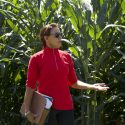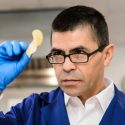State, local governments benefit from professor’s planning expertise
Thinking ahead generally does not top America’s to-do lists.
“As a society, we don’t often don’t put a high enough priority on planning for future growth and change,” says Brian Ohm, professor of urban and regional planning at the University of Wisconsin–Madison.
Ohm says that, as a people, Americans often resist planning anything. “This low priority applies not only to areas like planning for land use and community development – many other areas of our lives could benefit from better planning, for example, retirement planning.”
Or lack thereof. However, Ohm’s area is land use and community development, and he is on a mission to help improve planning practice in Wisconsin and beyond. An attorney by training and profession, Ohm holds a joint appointment with UW Extension and is an affiliate with the university’s Nelson Institute for Environmental Studies. As a state specialist in land use and planning law for Extension, he also works with county-based Extension educators and government officials throughout Wisconsin.
Since joining the UW–Madison faculty in 1994, Ohm has devoted his career to applied research and public service. Over the years, he has been a member of many state legislative, gubernatorial and local committees addressing various land use issues. He currently serves on the City of Madison Plan Commission and chairs the Dane County committee planning the North Mendota Parkway, as well a number of other local, state and national advisory panels.
“This type of service is natural for me, since both planning and law are very applied fields,” he says.
In addition, Ohm was a key architect of Wisconsin’s comprehensive planning and “Smart Growth” law, passed in 1999. The law grew out of his research on the need to update state laws governing local planning. This legislation provides a new framework for local governments to plan with an eye toward future implications of current actions.
“Many communities around the state are planning for the first time. The law makes state funds available to assist local planning efforts, and also encourages citizen participation in local planning processes,” Ohm says. “The best decisions often are made when there is a broad involvement of people, although that can be a slow and messy process. On the other hand, mistakes frequently are made when public involvement is limited.”
Still, significant obstacles remain, Ohm says. Confronting painful issues is often what stops the planning process in its tracks.
“Land use policy and community development can be extremely complex. Sometimes you have to address issues that people would rather talk around or ignore completely – for example, racism and the growing economic disparities in our country. Other times it’s a challenge to get decision-makers to understand how incremental decisions made over time can have such a tremendous impact on community form and environment,” he says.
However, Ohm points out that planners have made significant strides toward building livable communities for the 21st century and beyond.
“The growing awareness of problems like global climate change are driving the increased interest in sustainability,” he says. “Some people are beginning to rethink their choices about transportation, housing, food and so on.”
Ohm also finds that more and more individuals are beginning to appreciate links between public health concerns and the physical form of community development.
“For example, in some cases we inadvertently have designed our communities to make it very difficult for children to walk or ride their bikes to school. We are beginning now to explore the how this relates to the childhood obesity epidemic,” he says.
Ohm credits his architect father with piquing the younger Ohm’s interest in land use and community development. A UW–Madison alumnus in law and a history, he earned his bachelor’s from St. Olaf College in Northfield, Minn.
“One of the projects I did as an undergraduate there was an independent study on ‘model’ communities of tomorrow: Disneyland and Disney World. After I graduated from law school I began working for a large Twin Cities law firm and ended up being involved with several major planning projects such as redevelopment in downtown Minneapolis, efforts to site a new airport for the Twin Cities and early planning on the Light Rail Transit System there,” he says.
This semester Ohm is teaching a graduate course, Planning and the Legal System, offered by the department of urban and regional planning. He says that the interdisciplinary class focuses on the interplay between law and planning. He adds that his experiences planning projects in Wisconsin are giving his students a real-world starting point for their own inquiries.
“We’re looking at a variety of issues currently confronting the city of Madison, the state of Wisconsin and the world, from affordable housing to sustainable development practices,” he says.
In best Wisconsin Idea tradition, Ohm currently is collaborating with researchers from Spain, Germany and the Netherlands to do comparative investigations into ways to help decision makers set environmental policy. However, he says that his own first priority is Wisconsin.
“This state is a great laboratory for exploring sustainable land use and community development,” he says. “In the long run, I hope my work will help improve the practice of planning in Wisconsin.”
Subscribe to Wisconsin Ideas
Want more stories of the Wisconsin Idea in action? Sign-up for our monthly e-newsletter highlighting how Badgers are taking their education and research beyond the boundaries of the classroom to improve lives.



